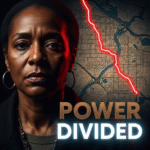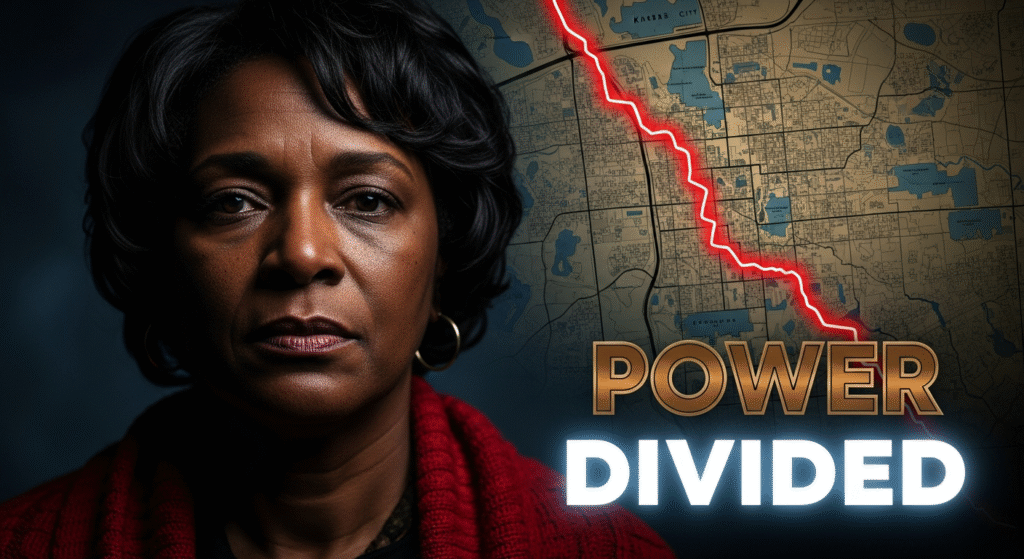

Missouri Redistricting and Black Political Power
By Darius Spearman (africanelements)
Support African Elements at patreon.com/africanelements and hear recent news in a single playlist. Additionally, you can gain early access to ad-free video content.
In Kansas City, Missouri, some lines are more than just marks on a map; they are scars from a long and painful history. The recent redrawing of U.S. congressional districts has reopened old wounds, particularly for the city’s Black neighborhoods. This legislative maneuver, pushed through in a special session, carves up Kansas City’s urban core using Troost Avenue, a notorious historical symbol of racial segregation (kcur.org). The new map threatens to weaken the Black vote by splitting communities and grouping them with distant, predominantly white rural areas. This move is not happening in a vacuum. Instead, it is the latest chapter in a decades-long struggle over political power and racial justice in Missouri.
The fight is centered on the 5th Congressional District, long represented by U.S. Rep. Emanuel Cleaver II, a respected Black Democratic leader (apnews.com). The new “Missouri First Map” breaks his district into three separate, Republican-leaning territories. Community leaders see this as a direct assault on Black political influence. They argue it is a calculated effort to dilute our voices and ensure that our concerns are drowned out. This redistricting battle, therefore, is about who gets to speak for Kansas City and whether the lines of power will be drawn to unite us or divide us.
The Rules of the Game: How Redistricting Dilutes Power
Redistricting is the process of redrawing the boundaries of electoral districts. It happens every ten years after the U.S. census to ensure each district has about the same number of people (lls.edu). While the goal is fair representation, the process can be manipulated to give one political party an advantage. This manipulation is called gerrymandering. For Black communities, gerrymandering often means diluting our political power, making it harder to elect candidates who represent our interests (brennancenter.org). This is achieved through two main tactics: “packing” and “cracking.”
“Packing” concentrates as many Black voters as possible into a single district (brennancenter.org). While this almost guarantees a win in that one district, it weakens our influence in all surrounding areas. “Cracking,” on the other hand, does the opposite. It splits Black communities apart, spreading our voters across several districts so we do not form a significant voting bloc in any of them (brennancenter.org). Both tactics are designed to reduce the overall strength of the Black vote. In Missouri, the recent rollback of redistricting reforms has made it easier to use these strategies to silence our voices politically.
A Dividing Line Through History: Troost Avenue’s Legacy
To understand why using Troost Avenue as a boundary is so painful, we must look at Kansas City’s history. Until the early 1900s, many neighborhoods were more integrated (kcur.org). However, as the city’s Black population grew, racist real estate practices took hold. Two of the most destructive were redlining and blockbusting. Redlining was a government-sanctioned practice where banks drew red lines on maps around Black neighborhoods, deeming them too “hazardous” for loans (consumerfinance.gov). This starved our communities of investment for decades.
Blockbusting was a predatory tactic where real estate agents would scare white families into selling their homes cheap by stoking fears of Black families moving in (britannica.com). They would then sell those same homes to Black families at inflated prices, as we had few other housing options (chicagohistory.org). These practices cemented Troost Avenue as a de facto line of segregation, meaning it was a racial divider in practice, even if not by law ([SOURCE-30], [SOURCE-6]). The legacy of this division is still visible today. For instance, in 2019, the white homeownership rate in Kansas City was 62%, while the Black homeownership rate was only 36% (kcur.org). This history makes the new map feel like a deliberate echo of past injustices.
College Attainment: Redlined KC vs. Missouri
The education gap highlights the lasting impact of segregation on opportunity in Kansas City ([SOURCE-6], [SOURCE-62]).
The Political Tug-of-War Over Fair Maps
Missouri’s journey with redistricting has been rocky. In 2018, voters passed “Clean Missouri,” a ballot initiative that created safeguards for racial and partisan fairness in map-drawing (kcur.org). It was a significant step toward a more just process. Unfortunately, those reforms were short-lived. In 2020, Amendment 3 rolled back most of “Clean Missouri,” restoring power to partisan-appointed commissions for drawing state legislative lines (kcur.org).
These commissions are stacked with political insiders. The governor appoints members from lists created by the two major political parties (ballotpedia.org). For a map to be approved, it needs a 70% supermajority vote from the commission (ballotpedia.org). If they cannot agree, the task falls to a panel of six appellate judges (ballotpedia.org). This system makes it far easier for the party in power to draw maps that benefit them, often at the expense of minority communities. This political reversal set the stage for the aggressive gerrymandering we are witnessing today.
A Washington Push Felt on Kansas City’s Streets
The current redistricting is unusual because it is happening mid-decade, outside of the normal census cycle (kcur.org). Governor Mike Kehoe called a special legislative session on August 29, 2025, to redraw congressional maps, a move driven by a national push from President Donald Trump to secure a Republican majority in Congress (kcur.org). While a president cannot legally force a state to redraw its maps, his political influence can pressure state leaders to act (princeton.edu). The governor’s special session led to the “Missouri First Map,” which he signed into law on September 28, 2025 (kcur.org).
This new map has been widely condemned as a political power grab. Kansas City Mayor Quinton Lucas called it a “political attack orchestrated by Washington elites” designed to silence local voices (kcur.org). Reverend Dr. Rodney Williams of Swope Parkway United Christian Church described it as “a slap in the face of the Black community” for its use of the historic Troost Avenue dividing line (kcur.org). These leaders see the map for what it is: an attempt to fracture Kansas City’s diverse urban core and dilute its collective political strength. Ultimately, the new lines serve distant political goals, not the needs of the people who live here.
Minority Population Shift in Missouri’s 5th District
The new map is projected to remove over 70,000 minority residents from the 5th District (kcur.org).
The Stark Reality of the New Numbers
The statistics behind the “Missouri First Map” paint a grim picture for minority representation. The 5th District is projected to lose over 70,000 minority residents, with its total minority population falling from 324,132 to 253,964 (kcur.org). Specifically, the district will see a 4.8% decrease in Black residents and a 9.1% decrease in minority residents overall. Conversely, its white population is set to increase by 8.5% (kcur.org). These numbers clearly show an effort to make the district whiter and more rural, diluting the urban vote.
The statewide impact is just as alarming. Missouri currently has two Black representatives in the U.S. House: Emanuel Cleaver and Cori Bush ([SOURCE-11], [SOURCE-60]). The new map is designed to create a 7-1 Republican advantage, which would almost certainly eliminate one of those seats (richmond.edu). Under this plan, non-Hispanic white people, who make up 62% of Missouri’s population, would hold 88% of its congressional seats (kcur.org). This is not proportional representation. Instead, it is a system where the political power of a minority of the population is systematically weakened.
Missouri Population vs. Congressional Representation
The new map creates a significant disparity between the state’s demographics and its political representation (kcur.org).
The Community Fights Back for Fair Representation
The fight against this gerrymandered map is already underway. The ACLU of Missouri and the NAACP have filed lawsuits, arguing that the map is unconstitutional because it intentionally diminishes Black voting power (kcur.org). These legal challenges are a crucial front in the battle for fair representation. They seek to block the map from being used in the 2026 elections and force the legislature to draw lines that respect community boundaries and protect minority voting rights.
In addition to legal action, opponents are organizing a statewide referendum. In Missouri, citizens can gather signatures to put a new law on the ballot for a public vote (ballotpedia.org). This process allows voters to overturn a law passed by the legislature. To succeed, petitioners must collect signatures from 5% of voters in at least six of the state’s eight congressional districts (ballotpedia.org). While it is a difficult path, it offers a powerful tool for the people to make their voices heard. This “redistricting civil war” is far from over. Therefore, the outcome will determine the shape of democracy in Missouri for years to come.
About the Author
Darius Spearman is a professor of Black Studies at San Diego City College, where he has been teaching for over 20 years. He is the founder of African Elements, a media platform dedicated to providing educational resources on the history and culture of the African diaspora. Through his work, Spearman aims to empower and educate by bringing historical context to contemporary issues affecting the Black community.
